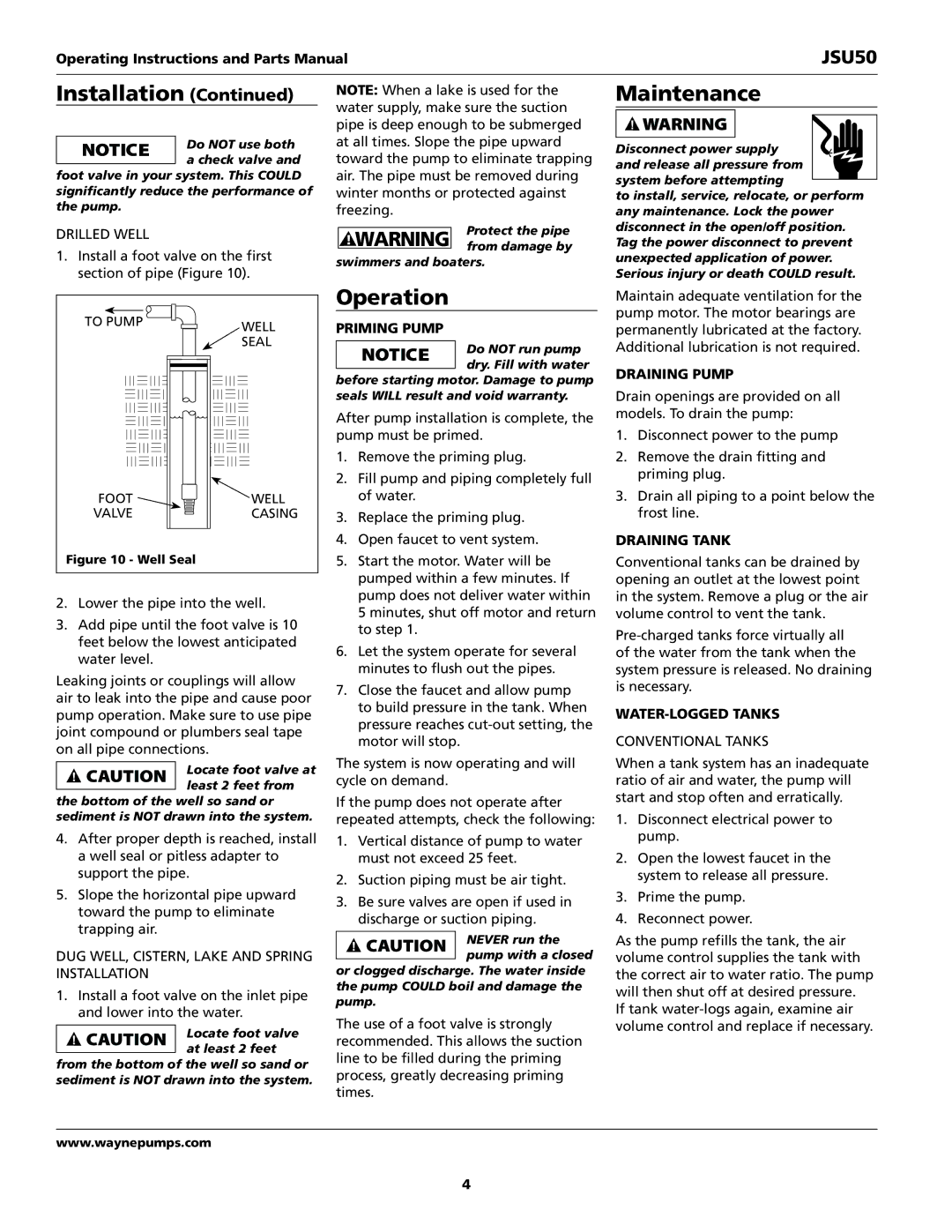
Operating Instructions and Parts Manual | JSU50 |
Installation (Continued)
Do not use both a check valve and foot valve in your system. This could
significantly reduce the performance of the pump.
Drilled Well
1.Install a foot valve on the first section of pipe (Figure 10).
To pump | Well |
| |
| Seal |
NOTE: When a lake is used for the water supply, make sure the suction pipe is deep enough to be submerged at all times. Slope the pipe upward toward the pump to eliminate trapping air. The pipe must be removed during winter months or protected against freezing.
| Protect the pipe | |
! WARNING | ||
from damage by | ||
|
swimmers and boaters.
Operation
priming pump
Do not run pump
Maintenance
Disconnect power supply and release all pressure from system before attempting
to install, service, relocate, or perform any maintenance. Lock the power disconnect in the open/off position. Tag the power disconnect to prevent unexpected application of power. Serious injury or death could result.
Maintain adequate ventilation for the pump motor. The motor bearings are permanently lubricated at the factory. Additional lubrication is not required.
Foot |
Valve |
![]() Well Casing
Well Casing
dry. Fill with water before starting motor. Damage to pump seals will result and void warranty.
After pump installation is complete, the pump must be primed.
1. | Remove the priming plug. |
2. | Fill pump and piping completely full |
| of water. |
3. | Replace the priming plug. |
4. | Open faucet to vent system. |
draining pump
Drain openings are provided on all models. To drain the pump:
1.Disconnect power to the pump
2.Remove the drain fitting and priming plug.
3.Drain all piping to a point below the frost line.
draining tank
Figure 10 - Well Seal
2.Lower the pipe into the well.
3.Add pipe until the foot valve is 10 feet below the lowest anticipated water level.
Leaking joints or couplings will allow air to leak into the pipe and cause poor pump operation. Make sure to use pipe joint compound or plumbers seal tape on all pipe connections.
Locate foot valve at least 2 feet from
the bottom of the well so sand or sediment is not drawn into the system.
4.After proper depth is reached, install a well seal or pitless adapter to support the pipe.
5.Slope the horizontal pipe upward toward the pump to eliminate trapping air.
Dug Well, Cistern, Lake And Spring Installation
1.Install a foot valve on the inlet pipe and lower into the water.
Locate foot valve at least 2 feet
from the bottom of the well so sand or sediment is not drawn into the system.
5. | Start the motor. Water will be |
| pumped within a few minutes. If |
| pump does not deliver water within |
| 5 minutes, shut off motor and return |
| to step 1. |
6. | Let the system operate for several |
| minutes to flush out the pipes. |
7. | Close the faucet and allow pump |
| to build pressure in the tank. When |
| pressure reaches |
| motor will stop. |
The system is now operating and will cycle on demand.
If the pump does not operate after repeated attempts, check the following:
1.Vertical distance of pump to water must not exceed 25 feet.
2.Suction piping must be air tight.
3.Be sure valves are open if used in discharge or suction piping.
Never run the pump with a closed
or clogged discharge. The water inside the pump could boil and damage the pump.
The use of a foot valve is strongly recommended. This allows the suction line to be filled during the priming process, greatly decreasing priming times.
Conventional tanks can be drained by opening an outlet at the lowest point in the system. Remove a plug or the air volume control to vent the tank.
water-logged tanks
conventional TANKS
When a tank system has an inadequate ratio of air and water, the pump will start and stop often and erratically.
1.Disconnect electrical power to pump.
2.Open the lowest faucet in the system to release all pressure.
3.Prime the pump.
4.Reconnect power.
As the pump refills the tank, the air volume control supplies the tank with the correct air to water ratio. The pump will then shut off at desired pressure.
If tank
www.waynepumps.com
4
